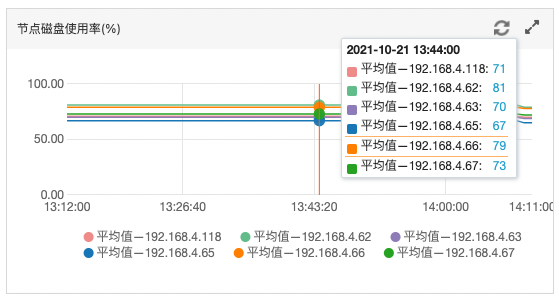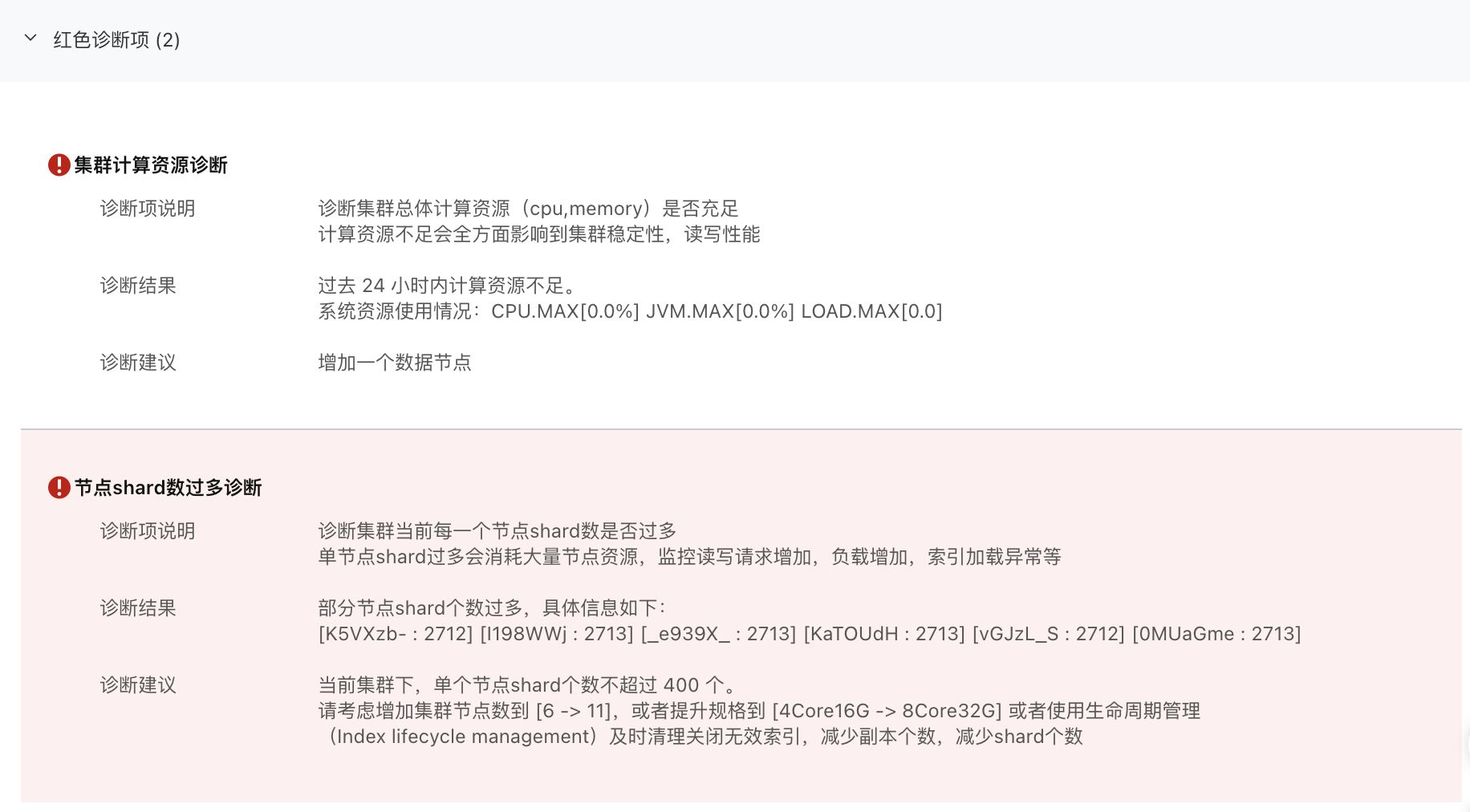这个问题的根源是某个 es 集群的分片数过多,集群负载太高,连带着导致 kibana 这边建立不了 index pattern。虽然最终解决还是选择了给集群升配,但这中间给索引做 redindex、shrink 等操作还是积攒了不少经验。
扫盲
在修复这个问题之前,其实我对 es 几乎一无所知,平时只是开发时会调 api 做一些搜索功能,或者只是用来埋点 debug,所以在修这个问题之前,我特地扫了一眼一些常用的概念,这里顺带记录下来,不感兴趣的可以跳过这一节。
1)文档 - document
文档是一个存储在 es 中的 json 文档,类比 mysql 中的一个数据行,需要依附于某张表
2)索引 - index
一组文档的集合,类似于 mysql 的 database,有一个或多个主分片(shard)和零个或多个副分片
3)类型 - type(已废弃)
原来是类比于 mysql 某个 database 的一个 table,但是因为 es 会认为同一个索引不同 type 下的两个同名字段是同一个,所以 type 这个概念其实没有存在的必要,后面也废弃了
4)分片 - shard
把一个大文件切分为小文件分散在多个节点上,类似于 mysql 中的分库分表,减轻单点压力,es 默认给每个索引分配 5 个主分片(primary shard),在索引创建前可以通过 number_of_shards 指定,但是一旦创建就没法直接修改,除非做一些 shrink 之类的操作。shard 的总数处理考虑 primaries 之外还要考虑下面提到的副本数
5)副本 - replica
某个文件的拷贝,这个概念是相对于 shard 而言的,如果你有一个索引,5 个 primary shard 和 1 个副本,那么最终总的 shard 为 5 + 5 * 1 = 10
6)映射 - mapping
类似 mysql 中某个 db 的 schema 定义,每个索引都要这样一个映射,定义了各个 field 的类型,这个映射可以自己定义,也可以自动生成
7)字段 - field
类比于 mysql 中的 column,就是各个字段名
问题定位
这个问题的表现是在 kibana 上 creat index pattern 的时候,一直转圈,新建不了,顺便还能看到有接口一直 504 了:

看监控能看到集群的磁盘占用率非常高,在清理了一批无用索引之后仍然有节点接近 85% 的警戒线:

同时请求了下面的接口看了一下集群目前的分片数,6 个节点总分片已经到了 16276,平均每个节点 2713 左右,远远超过了阿里云建议的每个节点 400 个分片左右:
GET _cat/health?v
看阿里云后台的诊断也能看出来:

咨询了阿里云技术支持,得到的回答是最我们扩容前磁盘占用率曾经到过 95%,触发了 es 配置的只读索引,需要跑下面的命令手动解除一下:
PUT _all/_settings
{
"index": {
"blocks": {
"read_only_allow_delete": null
}
}
}
但可气的是调这个 api 也 504 了,说明分片过多已经严重影响了集群的资源,这个想法也得到了阿里云技术支持的验证,现在看来 kibana 新建不了 index pattern 的罪魁祸首大概率是因为分片过多了。
那么这个问题无非就是从下面几个方面解了:
- 合并小索引到单个索引
- 缩减索引的分片
- 集群升配
问题解决
零、设置索引模板
在我们的集群默认配置下,es 新建的索引主分片是 5,副本是 1,不过对于一些预期比较小的索引、不是很重要的索引,这个配置是比较浪费的。
因此可以为它们建一个模板,统一的把这一类索引的主分片设置为 1 来达到增量数据缩减分片的目的,具体操作上可以在 kibana 的 dev tools 里执行下面的 api(one-shard 是你取的模板名):
PUT _template/one-shard
{
"index_patterns": [
"abc-*",
"xyz-*"
],
"settings": {
"index": {
"number_of_shards": "1"
}
}
}
设置了模板后,所有符合 index_patterns 配置的增量数据或者新建的索引都会使用这个模板将主分片数设为 1,同时对于存量的索引,我们也可以配合后面提到的 reindex 操作,把旧的主分片比较大的索引 reindex 到符合 index_patterns 的新索引上,然后删除旧索引来达到缩减分片的目的。
一、合并小索引到单个索引
es 里最符合合并小索引到单个索引的语义的 api 就是 reindex 了,可以把源索引搬到 dest 索引上:
POST _reindex
{
"source": {
"index": "my-index-000001"
},
"dest": {
"index": "my-new-index-000001"
}
}
甚至它还可以跨集群迁移:
POST _reindex
{
"source": {
"remote": {
"host": "http://otherhost:9200",
"username": "user",
"password": "pass"
},
"index": "my-index-000001",
"query": {
"match": {
"test": "data"
}
}
},
"dest": {
"index": "my-new-index-000001"
}
}
由于我们出问题的这个 es 集群主要是用来存业务埋点数据的,类似于日志记录,所以索引一般是按月按年来分组,比如一组常见的索引:
abc-2021.01
abc-2021.02
abc-2021.03
abc-2021.04
abc-2021.05
如果 abc 这个索引模式整体比较小,没有必要分块,就可以用 reindex 操作配合 one-shard 模板把它们合并成 1 个主分片为 1 副本为 1 的大索引 abc,假设之前每个小索引都有 5 个主分片和 1 个副本,那么我们就能省下:(5 + 1 * 5) * 5 - 2 = 23 个分片。
当然了,reindex 不止可以用于小索引合并到大索引,根据业务特点来看,像埋点、日志这种有明显冷热性质的数据,对于没有更新且几乎没有查询的旧的索引,即使比较大也是可以 reindex 到一个总的归档索引上的,具体就看取舍了。
当然实际操作中,我们也不会直接在 dev tools 中调 api 去做 reindex,而是会用 elasticsearch-curator 这个工具的官方镜像去维护一组 k8s job 分配一定的资源部署到线上执行,这里给一个例子:
# One-Time job
---
apiVersion: v1
kind: ConfigMap
metadata:
name: reindex-abc-config
namespace: guardian
labels:
name: curator
data:
migration_old-indices.yml: |-
# Remember, leave a key empty if there is no value. None will be a string,
# not a Python "NoneType"
#
# Also remember that all examples have 'disable_action' set to True. If you
# want to use this action as a template, be sure to set this to False after
# copying it.
actions:
1:
description: "Reindex remote index1 to local index1"
action: reindex
options:
wait_interval: 9
max_wait: -1
request_body:
source:
index: 'abc*$'
dest:
index: abc
filters:
- filtertype: none
---
apiVersion: v1
kind: ConfigMap
metadata:
name: reindex-abc-curator-config
namespace: guardian
labels:
name: curator
data:
curator_conf.yml: |-
# Remember, leave a key empty if there is no value. None will be a string,
# not a Python "NoneType"
client:
hosts:
- elasticsearch-databeat.guardian
port: 9200
url_prefix:
use_ssl: False
certificate:
client_cert:
client_key:
ssl_no_validate: False
http_auth: user:password
timeout: 30
master_only: False
logging:
loglevel: DEBUG
logfile:
logformat: default
blacklist: ['elasticsearch', 'urllib3']
---
apiVersion: batch/v1
kind: Job
metadata:
labels:
name: curator
tier: migration-job
name: curator-reindex-abc
namespace: guardian
spec:
backoffLimit: 4
parallelism: 1
template:
spec:
containers:
- args:
- --config
- /etc/curator/curator_conf.yml
- /etc/curator/reindex-abc.yml
env:
- name: ELASTICSEARCH_HOST_LOCAL
valueFrom:
secretKeyRef:
key: ELASTICSEARCH_HOST_LOCAL
name: elk-secrets
- name: ELASTICSEARCH_DATABEAT_PORT
valueFrom:
secretKeyRef:
key: ELASTICSEARCH_DATABEAT_PORT
name: elk-secrets
- name: ELASTICSEARCH_DATABEAT_AUTH
valueFrom:
secretKeyRef:
key: ELASTICSEARCH_DATABEAT_AUTH
name: elk-secrets
image: praseodym/elasticsearch-curator:latest
name: curator
resources: {}
volumeMounts:
- mountPath: /etc/curator/curator_conf.yml
name: config
readOnly: true
subPath: curator_conf.yml
- mountPath: /etc/curator/reindex-homies-app-jpush.yml
name: action-config
readOnly: true
subPath: reindex-homies-app-jpush.yml
dnsPolicy: ClusterFirst
restartPolicy: Never
volumes:
- configMap:
defaultMode: 0600
name: reindex-abc-curator-config
name: config
- configMap:
defaultMode: 0600
name: reindex-abc-config
name: action-config
二、缩减索引的分片
那么对于一些不太适合 reindex 到一个大索引里的数据,想要缩减分片应该如何处理呢?
其实 es 也提供了一个 shrink 操作,顾名思义就是瘦身,怎么使用可以看官方文档,它做的事情就是更改索引的配置,比如之前没有经过 one-shard 配置的索引可以通过 shrink 修改它的分片数,副本数之类的放到一个新索引上,然后删除旧索引,当然我这里的描述其实是非常简略的,这个具体过程大家可以自行搜索。
使用上可以给个例子:
---
apiVersion: v1
kind: ConfigMap
metadata:
name: curator-action-config-shrink
namespace: guardian
labels:
name: curator
data:
shrink_forcemerge.yml: |-
# Remember, leave a key empty if there is no value. None will be a string,
# not a Python "NoneType"
#
# Also remember that all examples have 'disable_action' set to True. If you
# want to use this action as a template, be sure to set this to False after
# copying it.
actions:
1:
action: shrink
description: >-
Shrink selected indices on the node with the most available space.
Delete source index after successful shrink, then reroute the shrunk
index with the provided parameters.
options:
disable_action: False
shrink_node: DETERMINISTIC
node_filters:
permit_masters: True
exclude_nodes: ['not_this_node']
number_of_shards: 1
number_of_replicas: 1
shrink_prefix:
shrink_suffix:
delete_after: True
wait_for_active_shards: 1
extra_settings:
settings:
index.codec: best_compression
wait_for_completion: True
wait_for_rebalance: True
copy_aliases: True
wait_interval: 9
max_wait: -1
filters:
- filtertype: pattern
kind: regex
value: '^abc-202(0|1).*?(?<!shrink)$'
2:
action: forcemerge
description: >-
Perform a forceMerge on selected indices to 'max_num_segments' per shard.
Skip indices that have already been forcemerged to the minimum number of
segments to avoid reprocessing.
options:
disable_action: False
max_num_segments: 2
timeout_override:
delay: 5
continue_if_exception: False
filters:
- filtertype: pattern
kind: regex
value: '^abc-202(0|1).*shrink$'
- filtertype: forcemerged
max_num_segments: 2
exclude:
---
apiVersion: v1
kind: ConfigMap
metadata:
name: curator-config-shrink
namespace: guardian
labels:
name: curator
data:
curator_conf.yml: |-
# Remember, leave a key empty if there is no value. None will be a string,
# not a Python "NoneType"
client:
hosts:
- elasticsearch-databeat.guardian
port: 9200
url_prefix:
use_ssl: False
certificate:
client_cert:
client_key:
ssl_no_validate: False
http_auth: user:password
timeout: 3600
master_only: False
logging:
loglevel: INFO
logfile:
logformat: default
blacklist: ['elasticsearch', 'urllib3']
---
apiVersion: batch/v1
kind: Job
metadata:
name: curator-shrink-es-indices
namespace: guardian
labels:
name: curator
tier: migration-job
spec:
template:
spec:
containers:
- name: curator
image: praseodym/elasticsearch-curator:latest
args:
- --config
- /etc/curator/curator_conf.yml
- /etc/curator/shrink_forcemerge.yml
env:
- name: ELASTICSEARCH_HOST_LOCAL
valueFrom:
secretKeyRef:
name: elk-secrets
key: ELASTICSEARCH_HOST_LOCAL
- name: ELASTICSEARCH_PORT
valueFrom:
secretKeyRef:
name: elk-secrets
key: ELASTICSEARCH_PORT
- name: ELASTICSEARCH_DATABEAT_AUTH
valueFrom:
secretKeyRef:
name: elk-secrets
key: ELASTICSEARCH_DATABEAT_AUTH
volumeMounts:
- name: config
mountPath: /etc/curator/curator_conf.yml
readOnly: true
subPath: curator_conf.yml
- name: action-config
mountPath: /etc/curator/shrink_forcemerge.yml
readOnly: true
subPath: shrink_forcemerge.yml
restartPolicy: Never
volumes:
- name: config
configMap:
defaultMode: 0600
name: curator-config-shrink
- name: action-config
configMap:
defaultMode: 0600
name: curator-action-config-shrink
操作效果是会把下面这些主分片为 5 副本数为 1 的索引都 shrink 成主分片为 1 副本数为 1 的小索引,索引名以 shrink 结尾:
abc-2020 -> abc-2020.shrink
abc-2021 -> abc-2021.shrink
三、集群升配
尽全力做完前两步之后,再看分片数:
GET _cat/health?v
epoch timestamp cluster status node.total node.data shards pri relo init unassign pending_tasks max_task_wait_time active_shards_percent
1635180165 00:42:45 es-cn-v0h1fbary000yaywp green 6 6 14396 7295 0 0 0 0 - 100.0%
已经从 16276 降到了 14396,节省了 1880 个分片,但是离阿里云建议的每个节点 400 个分片还是有很大差距。
到这一步其实已经是迫不得已了,毕竟阿里云的 es 集群升配每个月贵几千还是有一定成本的,不过在前面做了那么多优化处理的情况下,整个集群分配仍然还处于一个超高状态,那就不得不升配了,升配也有下面两个方向,具体看大家情况决定了:
- 加节点
- 提升单节点的 CPU 等指标
当然,最终选择升配也不代表前面所做的没有意义,毕竟配置索引模版、reindex、shrink 这些操作如果能提升到日常运维项中来,可以很大程度避免以后再出类似的状况。
效果
效果嘛当然就是 kibana 终于可以正常创建 index pattern 了:
